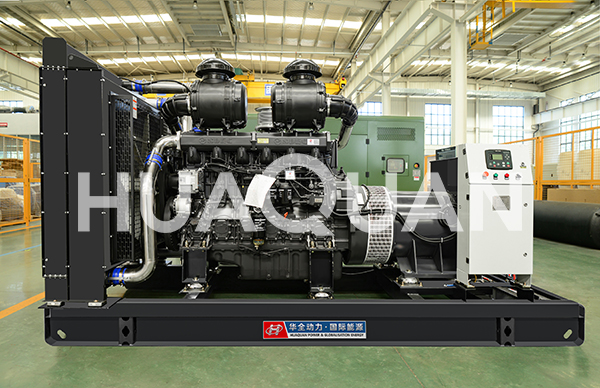
Power supply is crucial in modern construction. Whether it's the operation of large machinery or the use of workers' daily tools, a lack of stable power can severely impact construction progress. Therefore,
construction site generators have become indispensable equipment on construction sites. This article will discuss in detail the types, functions, selection guidelines, and importance of construction site generators.
II. Types of Construction Site Generators
Construction site generators are mainly divided into the following categories:
1. Diesel Generators
Diesel generators are widely used on construction sites due to their excellent efficiency and economy. They work by burning diesel fuel to generate mechanical energy, which is then converted into electrical energy. Compared to gasoline generators, diesel generators have higher output power and are typically used in construction sites with high power demand.
2. Gasoline Generators
- Gasoline generators are advantageous because they are lightweight and easy to operate, suitable for smaller projects or temporary construction sites. Although their power output is relatively lower, they perform well in powering small tools.
3. Mobile Generators
- Mobile generators are lightweight and equipped with wheels, making them easy to move around inside and outside the construction site. These generators are suitable for construction sites where occasional on-site relocation is required, such as highway and bridge projects.
4. Hybrid Generators
- With technological advancements, hybrid generators have gained attention. They combine multiple energy sources, such as diesel and solar power, saving fuel costs and reducing environmental pollution, making them an ideal choice for sustainable construction sites.
III. The Role of Construction Site Generators
The primary function of construction site generators is to provide a power supply, but their practical role extends far beyond this. Specific functions include:
1. Power Supply
Primarily providing power to various construction equipment. For example, heavy equipment such as chainsaws, welding machines, and concrete mixers all require a power supply to operate normally.
2. Ensuring Construction Safety
- Safety lights, warning lights, and monitoring equipment on the construction site all require a power supply. Generators ensure the long-term normal operation of these devices, providing a good safety guarantee for the construction site.
3. Supporting Temporary Office Environments
Many construction sites set up temporary offices, which require electricity to power equipment such as computers and copiers. Generators ensure the smooth operation of daily site management.
4. Improved Construction Efficiency
Generators on construction sites effectively prevent construction interruptions caused by power problems by providing a stable power supply, thereby improving overall construction efficiency.
IV. Construction Site Generator Purchasing Guide
When selecting a construction site generator, several factors need to be considered to ensure that the selected equipment can meet specific construction requirements.
1. Power Requirements
First, determine the power consumption required at the construction site. Calculate the power required for the equipment to be used simultaneously and select an appropriate generator power. It is generally recommended to choose a generator with a power slightly higher than the required power to cope with sudden power demands.
2. Fuel Type
- Choose the appropriate fuel based on the project budget and construction environment. Diesel generators are suitable for large projects, offering lower costs and high efficiency; while gasoline generators are more suitable for smaller projects, facilitating transport and operation.
3. Portability
- If the construction site frequently needs to be moved, choosing a lightweight generator with wheels will be more convenient. Meanwhile, choose generators with sturdy and durable casings and structures to withstand site conditions.
4. Maintenance and Service
Understand the brand's after-sales service policy and maintenance requirements. Some major brands offer advantages in later maintenance and parts replacement.
5. Noise Level
- Construction site generators generate noise during operation; therefore, choosing equipment with lower noise levels is more beneficial for workers and the surrounding environment.
V. Application Scenarios of Construction Site Generators
Construction site generators have a wide range of applications, mainly including:
1. Construction Sites
On construction sites, generators supply power to various construction equipment and tools, ensuring smooth construction operations.
2. Infrastructure Construction such as Railways, Highways, and Bridges
- These projects are often carried out in remote areas with unstable power supplies, making generators particularly important.
3. Emergency Power Supply
- When the mains power fails, generators can serve as backup power, ensuring the normal operation of the construction site and surrounding facilities.
4. Temporary Events and Exhibitions
- In venues requiring temporary power supply, such as exhibitions and gatherings, generators can also provide uninterrupted power support.
VI. Generator Operation Precautions
When using generators on construction sites, the following precautions should be taken to ensure safe and efficient operation:
1. Regular Inspection and Maintenance
- Regularly check the generator's oil level, fuel level, and engine oil to maintain normal operation. Furthermore, regular professional technical maintenance can extend the generator's lifespan.
2. Proper Layout
Please place the generator in a well-ventilated location, avoiding high temperatures and humidity. At the same time, ensure an appropriate safe distance between the generator and other equipment to prevent accidents.
3. Safe Operation
- Strictly follow the operating instructions and train workers to master the generator's operation methods to ensure safety on the construction site.
4. Emission Control
- Pay attention to generator exhaust emissions. Choose environmentally friendly generators whenever possible to minimize environmental impact on the construction site.
VII. Conclusion
In early construction projects, the application of construction site generators was often overlooked. However, with advancements in construction technology and rising electricity demand, their importance is becoming increasingly apparent. When purchasing generators, it is crucial to select appropriate power, fuel type, and portability to improve construction efficiency and safety. With the promotion of green building concepts, future construction site generators will increasingly trend towards environmental friendliness and high efficiency.
